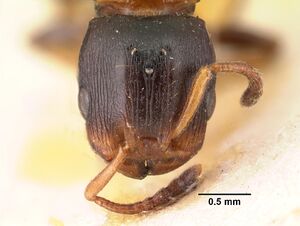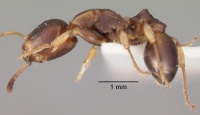Terataner elegans
| Terataner elegans | |
|---|---|

| |
| Scientific classification | |
| Kingdom: | Animalia |
| Phylum: | Arthropoda |
| Class: | Insecta |
| Order: | Hymenoptera |
| Family: | Formicidae |
| Subfamily: | Myrmicinae |
| Tribe: | Crematogastrini |
| Genus: | Terataner |
| Species: | T. elegans |
| Binomial name | |
| Terataner elegans Bernard, 1953 | |
Identification
Bolton (1981) - The four known species of the luteus-complex are confined to the forests of West and Central Africa. The complex is diagnosed by the short straight frontal carinae which fade out on the head behind the level of the eyes, fine sculpture, and sparse pilosity on the body; the tibiae lack standing hairs. Of the species thus defined two, Terataner elegans and Terataner luteus, have a broad flattened postpetiole, the posterior dorsal margin of which is broad and very broadly, evenly rounded. The other two species, Terataner piceus and Terataner velatus, have the posterior arch of the postpetiole narrow and narrowly rounded in dorsal view. T. elegans and luteus are very closely related, being separated mainly on colour (luteus is uniformly yellow), and on the dimensions of the pronotum. Apart from this the pronotum of luteus in dorsal view usually has the lateral margins more strongly convex than in elegans, though in smaller individuals this difference is often unapparent.
luteus - Colour uniform dull yellow. Pronotum broader than long, the pronotal width about equalling or distinctly exceeding the combined lengths of the pro- and mesonotum in dorsal view. At least in larger specimens the sides of the pronotum in dorsal view distinctly convex. Ground-sculpture on dorsum of head very feeble, sometimes almost effaced.
elegans - Colour blackish brown to black on head and gaster, alitrunk reddish or lighter brown. Pronotum about as long as broad, the pronotal width less than the combined lengths of the pro- and mesonotum in dorsal view. In all specimens the sides of the pronotum in dorsal view only very feebly convex. Ground-sculpture on dorsum of head superficial but dense and distinct.
Keys including this Species
Distribution
Distribution based on Regional Taxon Lists
Afrotropical Region: Ghana, Guinea (type locality), Nigeria, Uganda.
Distribution based on AntMaps
Distribution based on AntWeb specimens
Check data from AntWeb
Countries Occupied
| Number of countries occupied by this species based on AntWiki Regional Taxon Lists. In general, fewer countries occupied indicates a narrower range, while more countries indicates a more widespread species. |

|
Estimated Abundance
| Relative abundance based on number of AntMaps records per species (this species within the purple bar). Fewer records (to the left) indicates a less abundant/encountered species while more records (to the right) indicates more abundant/encountered species. |

|
Biology
Castes
Worker
Images from AntWeb
    
| |
| Worker. Specimen code casent0102230. Photographer April Nobile, uploaded by California Academy of Sciences. | Owned by NHMUK, London, UK. |
Queen
Images from AntWeb
   
| |
| Queen (alate/dealate). Specimen code casent0101456. Photographer April Nobile, uploaded by California Academy of Sciences. | Owned by MNHN, Paris, France. |
Nomenclature
The following information is derived from Barry Bolton's Online Catalogue of the Ants of the World.
- elegans. Terataner elegans Bernard, 1953b: 243, fig. 13A (q.) GUINEA.
- Type-material: holotype queen.
- Type-locality: Guinea: Kéoulenta (Lamotte).
- Type-depository: MNHN.
- Bolton, 1981b: 292 (w.).
- Status as species: Bolton, 1981b: 292 (redescription); Bolton, 1995b: 403.
- Distribution: Ghana, Guinea, Nigeria.
Unless otherwise noted the text for the remainder of this section is reported from the publication that includes the original description.
Description
Worker
Bolton (1981) - TL 4.9-5.6, HL 1.18-1.40, HW 1.12-1.30, CI 92-97, SL 0.72-0.82, SI 58-65, PW 0.78-0.88, AL 1.50-1.76 (20 measured).
Mandibles weakly longitudinally rugulose to almost smooth, frequently with distinctive large pits close to the masticatory (apical) margin. Frontal carinae a pair of close-set straight, almost parallel ridges which fade out posteriorly between the level of the posterior margins of the eyes and the occiput. Antennal scrobes absent. Maximum diameter of eye 0•24-0•28, about 0.22-0.24 x HW. Pronotum in dorsal view marginate anteriorly and laterally, with strongly angulate or short-denticulate anterior corners. On sides of the pronotum margination runs from the anterodorsal to anteroventral angles. Mesonotum marginate laterally and propodeum also with lateral margination though here it is much less sharply defined than on the pronotum and in a few specimens is better described as bluntly angular. Lateral parts of promesonotal suture visible on dorsum but centrally it is usually completely effaced. Metanotal groove feebly indicated in profile by a shallow concavity or feeble indentation. Dorsum of pronotum about as long as broad, its width obviously less than the combined lengths of the pronotum and mesonotum. Propodeum unarmed. Petiole node low-triangular in profile, rising to a dorsal peak. In anterior view the dorsal margin of the node strongly emarginate medially, the portions on each side of the emargination appearing as a pair of stout tubercles or blunt teeth. Postpetiole in dorsal view flattened, in some the dorsum appearing shallowly longitudinally concave; the posterior margin of the postpetiolar dorsum broad and broadly rounded. Dorsum of head between frontal carinae with superficial but dense punctulate to granular ground-sculpture, and with a few very weak longitudinal rugulae which are commonly broken or interrupted. Sides of head above eyes with the same ground-sculpture and also with longitudinal rugulae which are usually somewhat stronger than those on the dorsum. Dorsal alitrunk finely and densely reticulate-punctulate and with feeble longitudinal rugulae, at least on the promesonotum. Postpetiole dorsally with a few stout conspicuous rugae. First gastral tergite shagreened to finely superficially punctulate, with fine costulae on the basal portion. Hairs very sparse on dorsal surfaces of head and body, present on mouthparts and gastral apex but otherwise the maximum complement seeming to be 3-4 pairs on the head along the lines of the frontal carinae, one pair on the pronotal corners, one pair on the propodeum, one pair on the posterior face of the petiole node and 1-2 pairs each on the postpetiole and first gastral tergite. These hairs appear to be lost easily by abrasion and completely hairless individuals are frequent. Scapes and tibiae without standing hairs of any description. Colour usually with head and gaster blackish brown to black, the alitrunk lighter brown or more usually reddish. Mandibles and clypeus usually lighter in colour than rest of head.
Type Material
Bolton (1981) - Holotype female, Guinea: Keoulenta (Lamotte) (Musee National d'Histoire Naturelle) [examined].
References
- Bernard, F. 1953b [1952]. La réserve naturelle intégrale du Mt Nimba. XI. Hyménoptères Formicidae. Mém. Inst. Fr. Afr. Noire 19: 165-270 (page 243, fig. 13; queen described)
- Bolton, B. 1981. A revision of six minor genera of Myrmicinae (Hymenoptera: Formicidae) in the Ethiopian zoogeographical region. Bulletin of the British Museum (Natural History) Entomology. 43:245-307. PDF (page 292, worker described)
References based on Global Ant Biodiversity Informatics
- Bernard F. 1953. La réserve naturelle intégrale du Mt Nimba. XI. Hyménoptères Formicidae. Mémoires de l'Institut Français d'Afrique Noire 19: 165-270.
- Bolton B. 1981. A revision of six minor genera of Myrmicinae (Hymenoptera: Formicidae) in the Ethiopian zoogeographical region. Bulletin of the British Museum (Natural History). Entomology 43: 245-307.
- IZIKO South Africa Museum Collection

